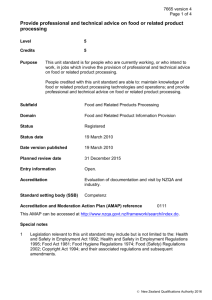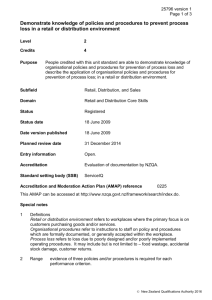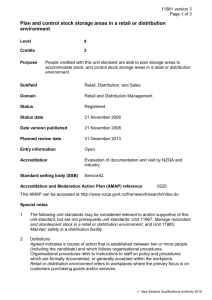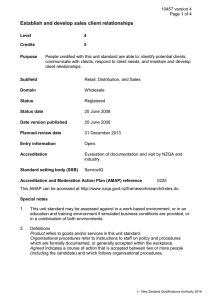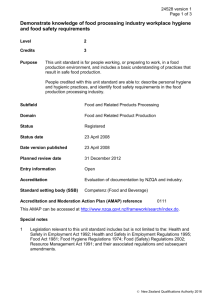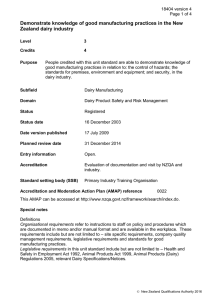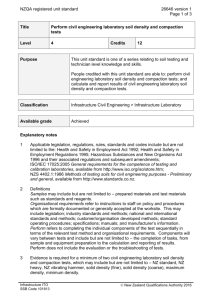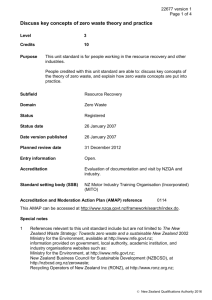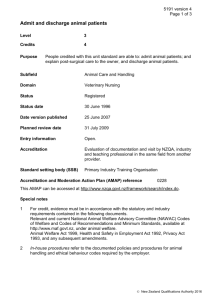19973 Monitor the implementation of an environmental
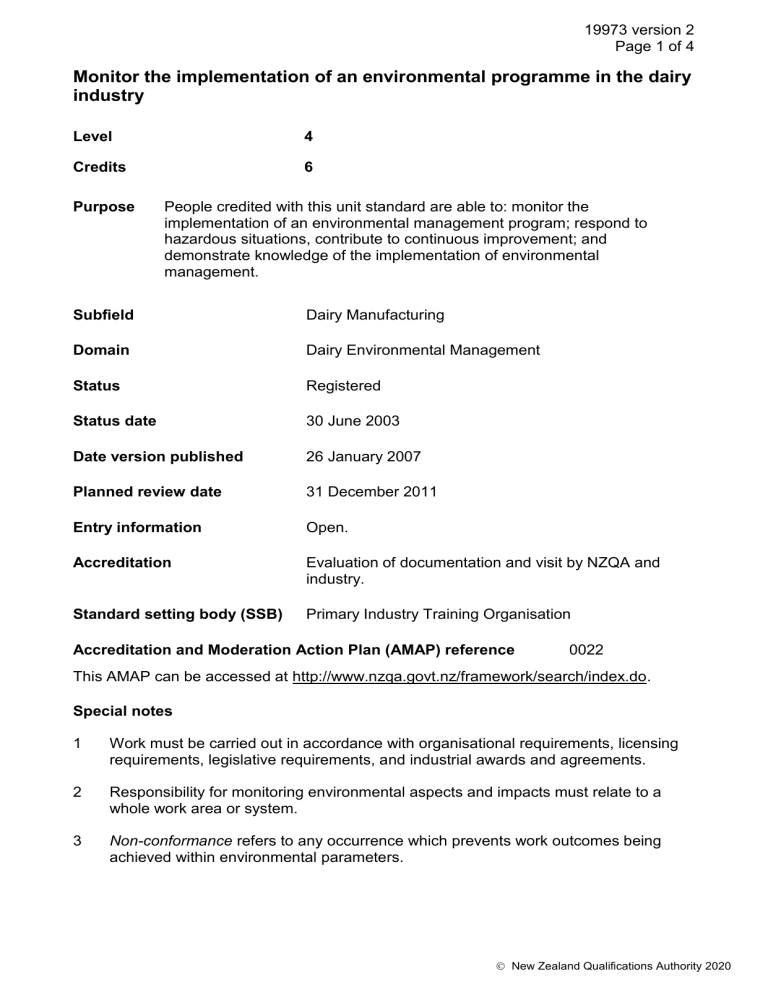
19973 version 2
Page 1 of 4
Monitor the implementation of an environmental programme in the dairy industry
Level 4
Credits 6
Purpose People credited with this unit standard are able to: monitor the implementation of an environmental management program; respond to hazardous situations, contribute to continuous improvement; and demonstrate knowledge of the implementation of environmental management.
Subfield Dairy Manufacturing
Domain
Status
Status date
Date version published
Dairy Environmental Management
Registered
30 June 2003
26 January 2007
Planned review date
Entry information
31 December 2011
Open.
Accreditation Evaluation of documentation and visit by NZQA and industry.
Standard setting body (SSB) Primary Industry Training Organisation
Accreditation and Moderation Action Plan (AMAP) reference 0022
This AMAP can be accessed at http://www.nzqa.govt.nz/framework/search/index.do.
Special notes
1 Work must be carried out in accordance with organisational requirements, licensing requirements, legislative requirements, and industrial awards and agreements.
2 Responsibility for monitoring environmental aspects and impacts must relate to a whole work area or system.
3 Non-conformance refers to any occurrence which prevents work outcomes being achieved within environmental parameters.
New Zealand Qualifications Authority 2020
19973 version 2
Page 2 of 4
4 Involvement in monitoring the implementation of the environmental management system includes participation in structured improvement programs and day-to-day problem solving.
5 An environmental aspect is any activity, product or service which has the potential to affect the environment.
6 An environmental impact is the actual problem or consequence which results from an environmental aspect.
7 Legislative requirements include but are not limited to the Hazardous Substances and New Organisms Act 1996, Resource Management Act 1991, relevant codes of practice, and subsequent amendments.
8 Organisational requirements refers to instructions to staff on policy and procedures which are documented in memo or manual format and are available in the workplace.
These requirements include but are not limited to – site specific requirements, company quality management requirements, and legislative requirements.
9 Environmental management system includes but is not limited to compliance with
AS/NZS ISO 14001:2004: Environmental Management Systems – Requirements with guidance for use.
Elements and performance criteria
Element 1
Monitor the implementation of the environmental management program.
Performance criteria
1.1 Environmental management requirements and procedures are communicated according to organisational requirements.
1.2 Implementation of procedures to support environmental management requirements is monitored according to organisational requirements.
Range monitoring could include but is not limited to – identification and assessment of environmental aspects and impacts, effectiveness of environmental controls, waste handling, waste treatment and disposal, work practices relating to environmental management, action to control emergency situations.
1.3 Mentoring and coaching support is provided to support individuals and groups to implement their environmental responsibilities.
New Zealand Qualifications Authority 2020
19973 version 2
Page 3 of 4
Element 2
Respond to hazardous situations.
Performance criteria
2.1 Actual and potential non-conformance is identified and corrective action taken and/or reported according to organisational requirements.
2.2 Procedures for controlling environmental impacts are implemented according to organisational requirements.
2.3 Environmental incidents are identified and corrected according to organisational requirements.
2.4 Causes of non-conformance are identified and control measures are implemented to prevent recurrence.
Element 3
Contribute to continuous improvement.
Performance criteria
3.1 Work practices and procedures are reviewed to identify environmental aspects and impacts according to organisational requirements.
3.2
3.3
Impacts are prioritised in terms of their risk assessment.
Options for controlling environmental impacts are identified and assessed according to organisational requirements.
3.4 Environmental objectives are compared against performance to determine opportunities for improvement.
3.5
Element 4
Procedures for implementing improvements are followed according to organisational requirements.
Demonstrate knowledge of the implementation of an environmental management program.
Performance criteria
4.1 The principles of environmental management are identified in terms of conservation of energy and resources and control of environmental impacts.
4.2
4.3
Regulatory requirements are identified in terms of environmental management.
Outputs from workplace processes are identified in terms of their effect on environmental impacts and risks.
New Zealand Qualifications Authority 2020
19973 version 2
Page 4 of 4
4.4 Technical and process knowledge is identified to determine options for addressing environmental impacts.
4.5 Reporting and auditing requirements are identified in terms of their application.
Please note
Providers must be accredited by the Qualifications Authority, or an inter-institutional body with delegated authority for quality assurance, before they can report credits from assessment against unit standards or deliver courses of study leading to that assessment.
Industry Training Organisations must be accredited by the Qualifications Authority before they can register credits from assessment against unit standards.
Accredited providers and Industry Training Organisations assessing against unit standards must engage with the moderation system that applies to those standards.
Accreditation requirements and an outline of the moderation system that applies to this standard are outlined in the Accreditation and Moderation Action Plan (AMAP). The
AMAP also includes useful information about special requirements for organisations wishing to develop education and training programmes, such as minimum qualifications for tutors and assessors, and special resource requirements.
Comments on this unit standard
Please contact the Primary Industry Training Organisation standards@primaryito.ac.nz if you wish to suggest changes to the content of this unit standard.
New Zealand Qualifications Authority 2020
